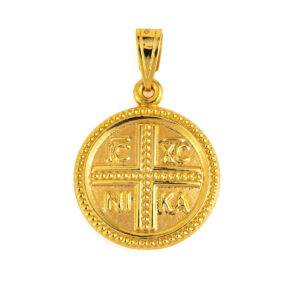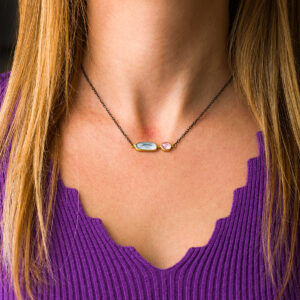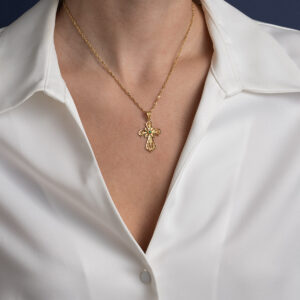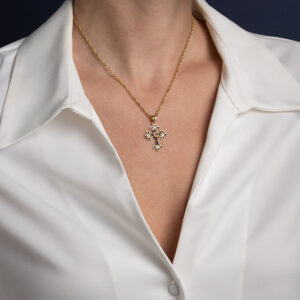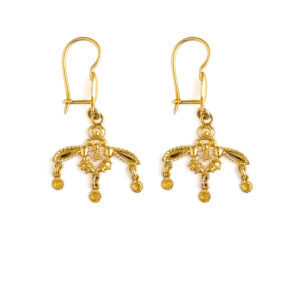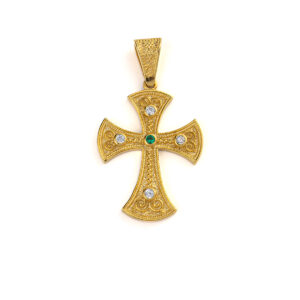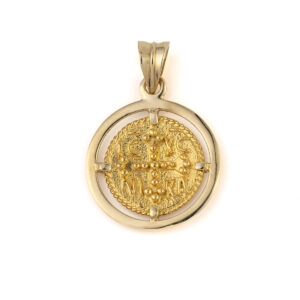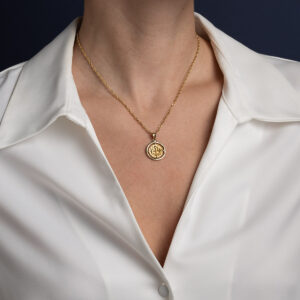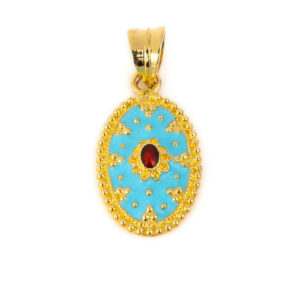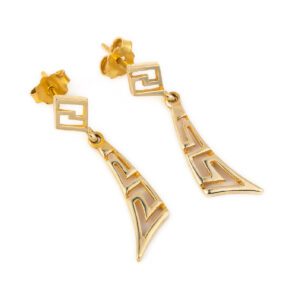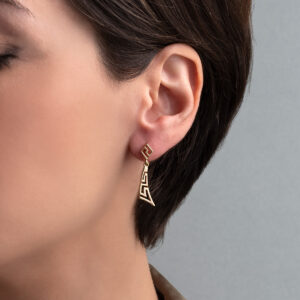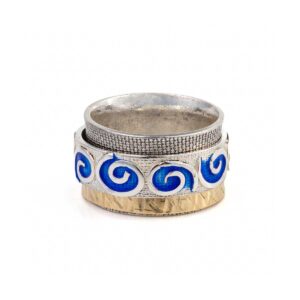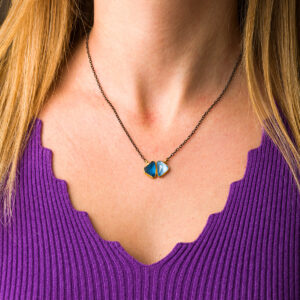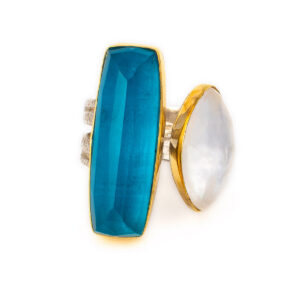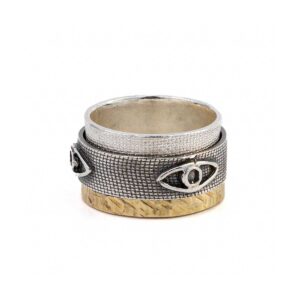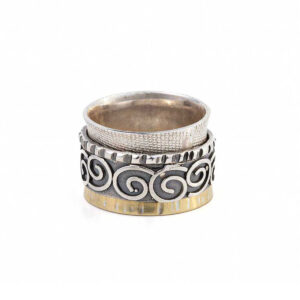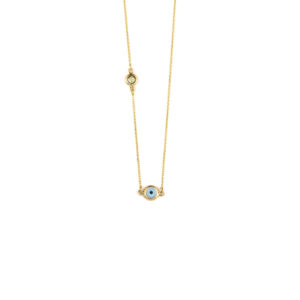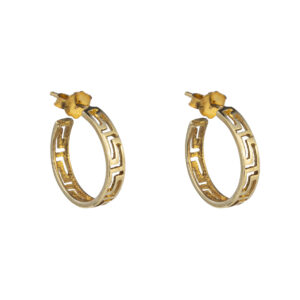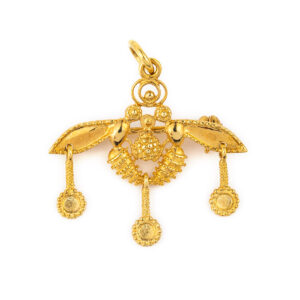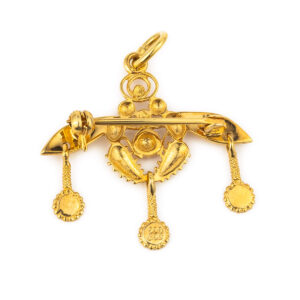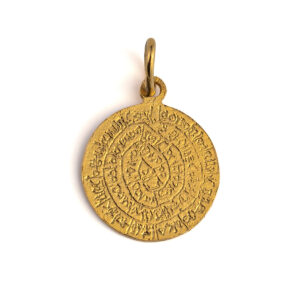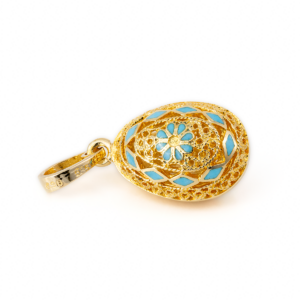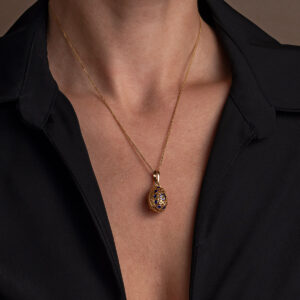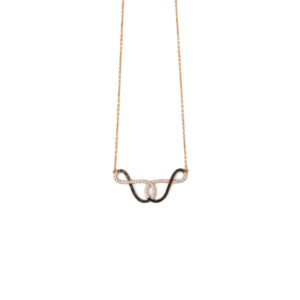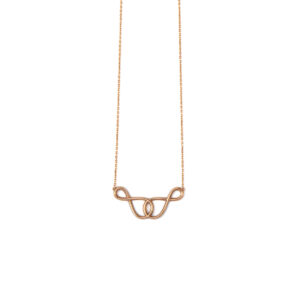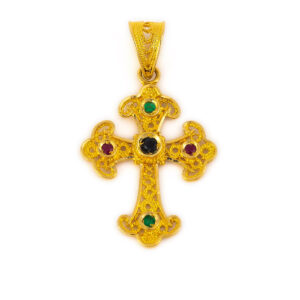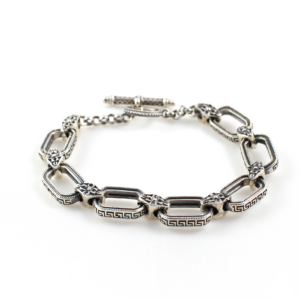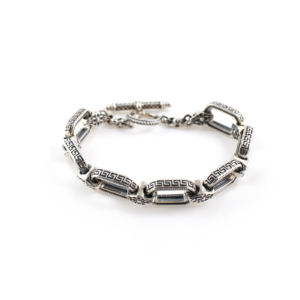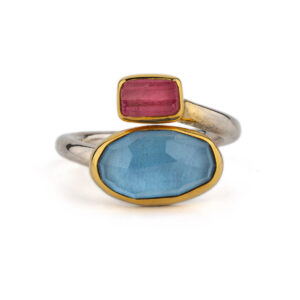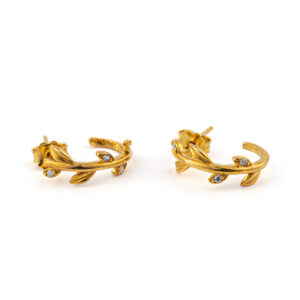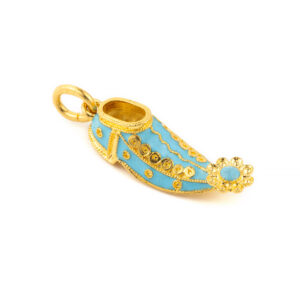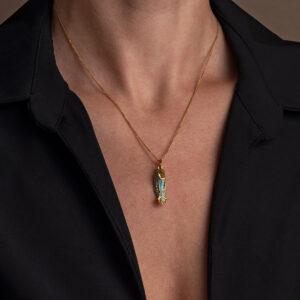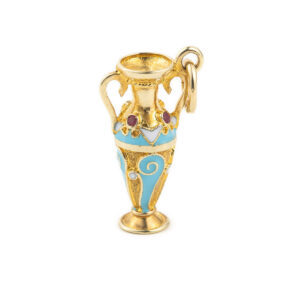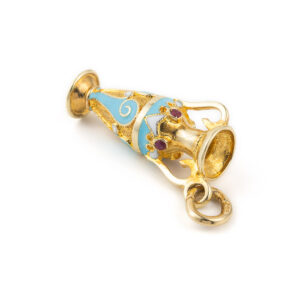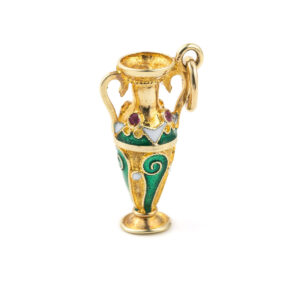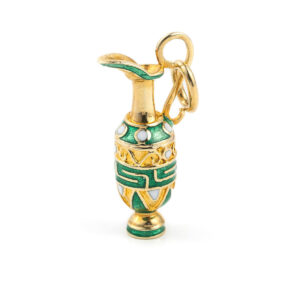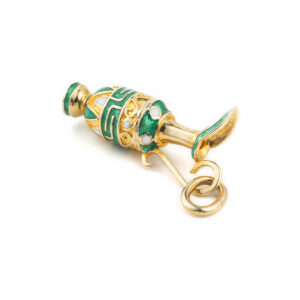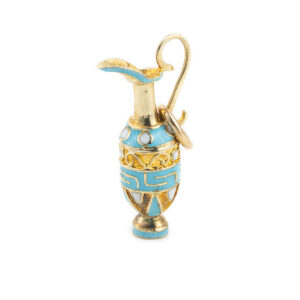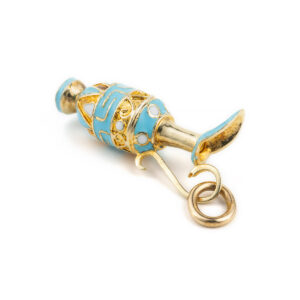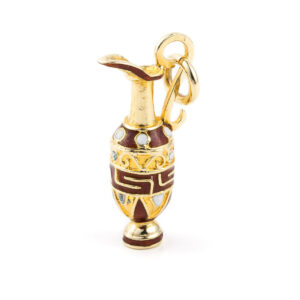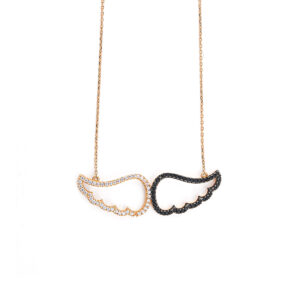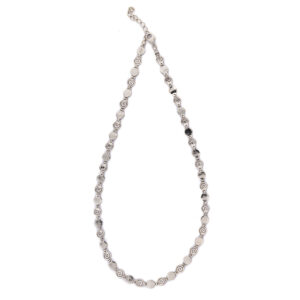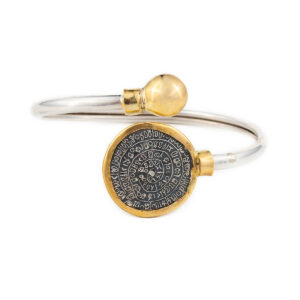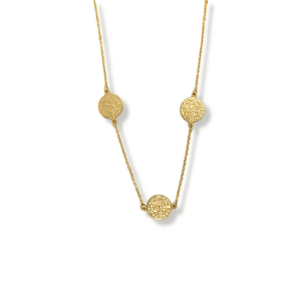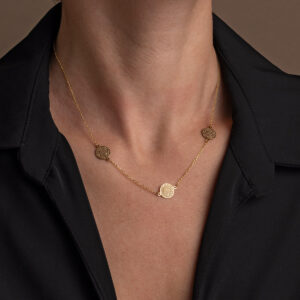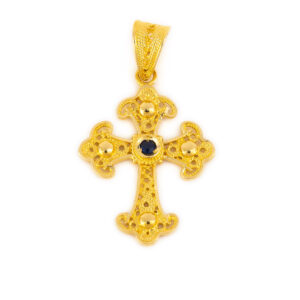Κωνσταντινάτος Σταυρός – Χρυσό 14Κ
115,00€ – 560,00€Κατασκευασμένο από 14Κ χρυσό.
Μενταγιόν που απεικονίζει τους Αγίους Κωνσταντίνο και Ελένη στη μία όψη και Χριστόγραμμα με τα αρχικά IC XC NIKA (ο Ιησούς Χριστός κατακτά) στην άλλη. Είναι ένα μοναδικό μενταγιόν που μπορείτε να το προσφέρετε στους ειδικούς σας ως δώρο προστασίας ή να το αγοράσετε για τον εαυτό σας.
Χειροποίητο ελληνικό κόσμημα.
Κολιέ με Ακουαμαρίνα και Ροζ χαλαζία – Χρυσό 18 Καρατίων και Ασήμι 925
Κολιέ με Ροζ χαλαζία και Ακουαμαρίνα σε ασήμι και χρυσό Κ18. Περιλαμβάνεται ασημένια αλυσίδα μήκους 40cm. Για μοναδικές εμφανίσεις γεμάτες χρώμα! Κάθε κόσμημα της σειράς είναι μοναδικό.
Κολιέ με Blue London Τοπάζ και Ακουαμαρίνα – Χρυσό 18 Καρατίων και Ασήμι 925
Κολιέ με Blue London Τοπάζ και Ακουαμαρίνα σε ασήμι και χρυσό Κ18. Περιλαμβάνεται ασημένια αλυσίδα μήκους 40cm. Για μοναδικές εμφανίσεις γεμάτες χρώμα! Κάθε κόσμημα της σειράς είναι μοναδικό.
18K Gold Filigree Cross with Emerald
546,00€Byzantine Cross is embellished with a fine filigree, a emerald gemstone in the middle and granules of precious metal.
Handmade with the great attention to detail. Inspired by Byzantine art.
Made in 18k gold
Filigree is a delicate kind of jewellery metalwork, made with tiny beads or twisted threads, or both in combination, soldered together or to the surface of an object of the same metal and arranged in artistic motifs. The art of filigree dates back to ancient history. The first of the found jewelry in this technique have been found in Mesopotamia and dates to thousands of years BC. In the ancient world and particularly in Asia Minor, this art grew were at the highest level.
Granulation (from Latin: granum = “grain”) is a jewellery technique whereby a surface of a jewel is covered with small spheres or granules of precious metal. The technique is thought to have its origins in Mesopotamia about 5,000 years ago.
18K Gold Filigree Cross with Ruby
546,00€Byzantine Cross is embellished with a fine filigree, a ruby gemstone in the middle and granules of precious metal.
Handmade with the great attention to detail. Inspired by Byzantine art.
Made in 18k gold.
The chain shown is our 14K Gold Rope Chain (not included).
Filigree is a delicate kind of jewellery metalwork, made with tiny beads or twisted threads, or both in combination, soldered together or to the surface of an object of the same metal and arranged in artistic motifs. The art of filigree dates back to ancient history. The first of the found jewelry in this technique have been found in Mesopotamia and dates to thousands of years BC. In the ancient world and particularly in Asia Minor, this art grew were at the highest level.
Granulation (from Latin: granum = “grain”) is a jewellery technique whereby a surface of a jewel is covered with small spheres or granules of precious metal. The technique is thought to have its origins in Mesopotamia about 5,000 years ago.
Byzantine Filigree Sapphire Cross in 18K Gold
546,00€Byzantine Cross is embellished with a fine filigree and a sapphire gemstone in the middle.
Handmade with the great attention to detail. Inspired by Byzantine art.
Made in 18k gold
Filigree is a delicate kind of jewellery metalwork, made with tiny beads or twisted threads, or both in combination, soldered together or to the surface of an object of the same metal and arranged in artistic motifs. The art of filigree dates back to ancient history. The first of the found jewelry in this technique have been found in Mesopotamia and dates to thousands of years BC. In the ancient world and particularly in Asia Minor, this art grew were at the highest level.
18K Gold and Turquoise Enamel Byzantine Ruby Cross
546,00€Byzantine Cross is embellished with turquoise and white enamel, a rosette flower in the center which is decorated with a ruby and granules of precious metal.
The back side of the cross has not decoration. Available with green enamel. Choose your preferred enamel color.
Handmade with the great attention to detail. Inspired by Byzantine art.
Made in 18k gold
Filigree is a delicate kind of jewellery metalwork, made with tiny beads or twisted threads, or both in combination, soldered together or to the surface of an object of the same metal and arranged in artistic motifs. The art of filigree dates back to ancient history. The first of the found jewelry in this technique have been found in Mesopotamia and dates to thousands of years BC. In the ancient world and particularly in Asia Minor, this art grew were at the highest level.
Granulation (from Latin: granum = “grain”) is a jewellery technique whereby a surface of a jewel is covered with small spheres or granules of precious metal. The technique is thought to have its origins in Mesopotamia about 5,000 years ago.
Rosette flower
The rosette (rose) is a timeless jewel, symbol and amulet. The origin of the term is the Greek word for rose – rodon (ρόδον). Its use began in the Mycenaean era and continues as far as the 2nd millennia BC. The Mycenaean Rosette is a motif that was widespread throughout Mesopotamia, Egypt, Greece and other ancient civilizations. It is inspired by a Mycenaean rosette bead, found at Mycenae, dated to 1400-1300 B.C. The rosette were used extensively in ancient Greek Mycenaean jewels, in architecture, pottery and in sculptures from 1500 BC. Mycenaean rosettes usually had 6 or 8 or 12 leaves, and sixteen leaves during the Macedonian Dynasty. Such details as the rodax shape and the number of leaves tend to vary with the era or beliefs. The rosettes were used to decorate the cloths, the belts and wreaths of the Kings. The number of leaves had a symbolic character each time. The four elements of nature (wind, earth, fire, water), the seven wonders of the ancient world or the twelve gods of ancient Greeks and the world domination and radiance of the Kings of Macedonia. They were signs of beauty, purity, eugenics, worship and power. Rosette or Rodax was probably the most popular and favorite decorative element in Mycenaean era, classical antiquity and Byzantine times.
18K Gold and Blue Enamel Byzantine Ruby Cross
546,00€Byzantine Cross is embellished with blue and white enamel, a rosette flower in the center which is decorated with a ruby and granules of precious metal.
The back side of the cross has not decoration. Available with turquoise enamel. Choose your preferred enamel color.
Handmade with the great attention to detail. Inspired by Byzantine art.
Made in 18k gold
Filigree is a delicate kind of jewellery metalwork, made with tiny beads or twisted threads, or both in combination, soldered together or to the surface of an object of the same metal and arranged in artistic motifs. The art of filigree dates back to ancient history. The first of the found jewelry in this technique have been found in Mesopotamia and dates to thousands of years BC. In the ancient world and particularly in Asia Minor, this art grew were at the highest level.
Granulation (from Latin: granum = “grain”) is a jewellery technique whereby a surface of a jewel is covered with small spheres or granules of precious metal. The technique is thought to have its origins in Mesopotamia about 5,000 years ago.
Rosette flower
The rosette (rose) is a timeless jewel, symbol and amulet. The origin of the term is the Greek word for rose – rodon (ρόδον). Its use began in the Mycenaean era and continues as far as the 2nd millennia BC. The Mycenaean Rosette is a motif that was widespread throughout Mesopotamia, Egypt, Greece and other ancient civilizations. It is inspired by a Mycenaean rosette bead, found at Mycenae, dated to 1400-1300 B.C. The rosette were used extensively in ancient Greek Mycenaean jewels, in architecture, pottery and in sculptures from 1500 BC. Mycenaean rosettes usually had 6 or 8 or 12 leaves, and sixteen leaves during the Macedonian Dynasty. Such details as the rodax shape and the number of leaves tend to vary with the era or beliefs. The rosettes were used to decorate the cloths, the belts and wreaths of the Kings. The number of leaves had a symbolic character each time. The four elements of nature (wind, earth, fire, water), the seven wonders of the ancient world or the twelve gods of ancient Greeks and the world domination and radiance of the Kings of Macedonia. They were signs of beauty, purity, eugenics, worship and power. Rosette or Rodax was probably the most popular and favorite decorative element in Mycenaean era, classical antiquity and Byzantine times.
As in all handmade items there may be small differences in weight and dimensions and this is what makes them unique and precious.
Minoan Malia Bees Dangle Earrings – 14K Solid Yellow Gold
544,00€Dangle earrings inspired by the ancient Minoan Greek Malia bees pendant.
Made of 14K Gold.
Handmade item.
The Minoan Bees Pendant, one of the most famous Minoan artworks, was discovered in the Old Palace cemetery at Chrysolakkos, outside the palace of Malia, the third largest and most significant known Minoan palace after Knossos and Phaistos. Chryssolakkos means the “Pit of gold” because of the many precious objects that were found there. The famous pendant dates back to the Bronze Age, (1800 BC) and it’s an stunning, very detailed representation of two bees or wasps storing away a drop of honey to their honeycomb. This pendant is one of the most famous exhibits in the wonderfully Heraklion archeological museum.
As in all handmade items there may be small differences in weight and dimensions and this is what makes them unique and precious.
Σκουλαρίκια Aqua Marine – 18Κ Χρυσό και Ασήμι 925
Κατασκευασμένα από χρυσό 18Κ και ασήμι 925.
Διακοσμημένα με aqua marine.
Χειροποίητο ελληνικό κόσμημα.
Όπως σε όλα τα χειροποίητα αντικείμενα μπορεί να υπάρχουν μικρές διαφορές σε βάρος και διαστάσεις και αυτό είναι που τα κάνει μοναδικά και πολύτιμα.
Χρυσός Βυζαντινός Σταυρός 14 Καρατίων με Ζιργκόν
535,00€Όμορφος κρεμαστός σταυρός από ατόφιο χρυσό 14Κ.
Χειροποίητο Ελληνικό Κόσμημα
Οι σταυροί βάπτισης και οι εσταυρωμένοι βάπτισης είναι κλασικά δώρα για ένα παιδί και τους γονείς του για την ειδική περίσταση της βάπτισης ενός παιδιού.
Ανακαλύψτε τη Συλλογή Πίστη
Δαχτυλίδι Αμαζονίτης και Λάπις Λάζουλι – Χρυσό 18Κ και Ασήμι 925
Κατασκευασμένο από 18Κ χρυσό και ασήμι 925.
Διακοσμημένο με Αμαζονίτη και Λάπις Λάζουλι
Χειροποίητο ελληνικό κόσμημα.
Όπως σε όλα τα χειροποίητα είδη μπορεί να υπάρχουν μικρές διαφορές σε βάρος και διαστάσεις και αυτό είναι που τα κάνει μοναδικά και πολύτιμα.
Βυζαντινός Σταυρός – 18Κ Χρυσό
530,00€Byzantine Cross embellished with a fine filigree.
Handmade with the great attention to detail. Inspired by Byzantine art.
Made in 18k gold
Filigree is a delicate kind of jewellery metalwork, made with tiny beads or twisted threads, or both in combination, soldered together or to the surface of an object of the same metal and arranged in artistic motifs. The art of filigree dates back to ancient history. The first of the found jewelry in this technique have been found in Mesopotamia and dates to thousands of years BC. In the ancient world and particularly in Asia Minor, this art grew were at the highest level.
Μενταγιόν Κωνσταντινάτο – 14Κ Χρυσό
529,00€Κατασκευασμένο από Χρυσό 14Κ.
Χειροποίητο Ελληνικό Κόσμημα.
Μενταγιόν από Χρυσό 18Κ με Τυρκουάζ Σμάλτο
528,00€Βυζαντινό μενταγιόν διακοσμημένο με λεπτό φιλιγκράν, τυρκουάζ σμάλτο και κόκκους από πολύτιμο μέταλλο. Χειροποίητο ελληνικό προιόν με μεγάλη προσοχή στη λεπτομέρεια.
Εμπνευσμένο από τη βυζαντινή τέχνη.
Κατασκευασμένο από χρυσό 18 καρατίων
Η κοκκοποίηση (από τα λατινικά: granum = «κόκκος») είναι μια τεχνική κοσμηματοποιίας με την οποία η επιφάνεια ενός κοσμήματος καλύπτεται με μικρές σφαίρες ή κόκκους πολύτιμου μετάλλου. Η τεχνική θεωρείται ότι έχει τις ρίζες της στη Μεσοποταμία πριν από περίπου 5.000 χρόνια.
Σκουλαρίκια Aqua Marine – Χρυσό 18Κ και Ασήμι 925
Κατασκευασμένο από 18Κ χρυσό και ασήμι 925.
Διακοσμημένο με Aqua Marine
Χειροποίητο ελληνικό κόσμημα.
Όπως σε όλα τα χειροποίητα είδη μπορεί να υπάρχουν μικρές διαφορές σε βάρος και διαστάσεις και αυτό είναι που τα κάνει μοναδικά και πολύτιμα.
Σκουλαρίκια Μαίανδρος – 14Κ Χρυσο
527,00€Gold Geometrical Meander Earrings.
Meandros design is a decorative border constructed from a continuous line, shaped into a repeated motif. Such a design is also called the Greek fret or Greek key design, although these are modern designations. One the one hand, the name “meander” recalls the twisting and turning path of the Meander River in Asia Minor, and on the other hand, as Karl Kerenyi pointed out, “the meaning is that these is no beginning and to end end in some cases so it become thwe symbol of long life and eternity.
Handmade item.
Δαχτυλίδι Spinner με Μπλε Σπείρες – Χρυσό 14Κ και Ασήμι 925
Φτιαγμένο από Χρυσό 14Κ και Ασήμι 925.
Χειροποίητο Ελληνικό Κόσμημα
Κολιέ με Ακουαμαρίνα και Τοπάζ – Χρυσό 18 Καρατίων και Ασήμι 925
Κολιέ με τοπάζ και ακουαμαρίνα σε ασήμι και χρυσό Κ18. Περιλαμβάνεται ασημένια αλυσίδα μήκους 40cm. Για μοναδικές εμφανίσεις γεμάτες χρώμα! Κάθε κόσμημα της σειράς είναι μοναδικό.
Δαχτυλίδι Pariba Doublet και Πέρλα – Χρυσό 18Κ και Ασήμι 925
Κατασκευασμένο από 18Κ χρυσό και ασήμι 925.
Διακοσμημένο με πέτρα Pariba και πέρλα
Χειροποίητο ελληνικό κόσμημα.
Όπως σε όλα τα χειροποίητα είδη μπορεί να υπάρχουν μικρές διαφορές σε βάρος και διαστάσεις και αυτό είναι που τα κάνει μοναδικά και πολύτιμα.
Τα κοσμήματα Doublet είναι ένα πολύ ιδιαίτερο κόσμημα λόγω του τρόπου σύνθεσής του. Με αυτη την τεχνική υπάρχει η ενοποίηση δύο πολύτιμων λίθων, (χαλαζίας και μια άλλη μη διαφανή πέτρα) δημιουργώντας μοναδικά χρώματα και λάμψη.
Δαχτυλίδι Spinner με Μάτι – Χρυσό 14Κ και Ασήμι 925
Φτιαγμένο από Χρυσό 14Κ και Ασήμι 925.
Χειροποίητο Ελληνικό Κόσμημα
Δαχτυλίδι Spinner με Σπείρα – Χρυσό 14Κ και Ασήμι 925
Φτιαγμένο από Χρυσό 14Κ και Ασήμι 925.
Χειροποίητο Ελληνικό Κόσμημα
Κολιέ με Μάτι Κυκλικό – 14Κ Χρυσό
510,00€Φτιαγμένο από χρυσό 14Κ.
Χειροποίητο κόσμημα.
The symbol and superstition of the evil eye is one of the strongest symbolic images in the world. The earliest known evidence for belief in the evil eye goes back to ancient Greece and Rome. It is supposed to wear off evil to anyone who wears it.
Σκουλαρίκια Κρίκοι με Μαίανδρο – Χρυσό 14Κ
289,00€ – 510,00€Το σχέδιο του Μαιάνδρου είναι ένα διακοσμητικό περίγραμμα κατασκευασμένο από μια συνεχή γραμμή, διαμορφωμένο σε ένα επαναλαμβανόμενο μοτίβο. Το συναντάμε επίσης με την ονομασία “ελληνικό κλειδί”. Από τη μία πλευρά, το όνομα μαίανδρος θυμίζει τη στροφή του ποταμού Μαιάνδρου στη Μικρά Ασία, και από την άλλη, όπως τόνισε ο Karl Kerenyi, «ο μαίανδρος είναι η μορφή ενός λαβύρινθου σε γραμμική μορφή». Λόγω της έλλειψης αρχής και τέλους, γίνεται το σύμβολο της μακράς ζωής και της αιωνιότητας. Ένα από τα αρχαιότερα μοτίβα που έχει διακοσμήσει πολλούς ναούς και αγάλματα.
Χειροποίητο ελληνικό κόσμημα.
Όπως σε όλα τα χειροποίητα αντικείμενα μπορεί να υπάρχουν μικρές διαφορές στο βάρος και τις διαστάσεις και αυτό είναι που τα κάνει μοναδικά και πολύτιμα.
Μενταγιόν Μινωική Μέλισσα – 14Κ Χρυσό
510,00€Greek Ancient Minoan Bees Pendant In 14k Gold. The Malia honeybee pendant was discovered at Chryssolakkos, of the Minoan Palace of Malia on the island of Crete, and is thought to date to c.1800 BC. The named Chryssolakkos that means the “pit of gold” because of the precious objects that the farmers used to find there. The Minoan Palace is situated 3 km east of Malia town and is the third most significant known Minoan Palace after Knossos and Phaistos.
This pendant is in the shape of two bees, or wasps, storing away a drop of honey in a comb.
Made in 14k yellow gold
Handmade item.
Μενταγιόν Φαιστός – Χρυσό 14Κ
272,00€ – 510,00€Phaistos Disc Pendant in 14k Gold. The Phaistos Disc is a disk of fired clay from the Minoan palace of Phaistos on the island of Crete. Now, the island of Crete is part of modern Greece. The disc was discovered in 1908 by the Italian archaeologist Luigi Pernier in the Minoan palace-site of Phaistos. While it is not clear that it is a script, most attempted decipherments assume that it is; most additionally assume a syllabary, others an alphabet or logography or a calendar.
Handmade item.
Filigree Egg Pendant with Rosette Flower – 14k Gold and Turquoise Enamel
510,00€The pendant is embellished with a fine filigree and turquoise enamel.
Used as a charm or as a pendant.
Pick up a beautiful gift inspired by the majestic art of Fabergé!
Made in 14k yellow gold
Filigree is a delicate kind of jewellery metalwork, made with tiny beads or twisted threads, or both in combination, soldered together or to the surface of an object of the same metal and arranged in artistic motifs. The art of filigree dates back to ancient history. The first of the found jewelry in this technique have been found in Mesopotamia and dates to thousands of years BC. In the ancient world and particularly in Asia Minor, this art grew were at the highest level.
Rosette The rosette (rose) is a timeless jewel, symbol and amulet. The origin of the term is the Greek word for rose – rodon (ρόδον). Its use began in the Mycenaean era and continues as far as the 2nd millennia BC. The Mycenaean Rosette is a motif that was widespread throughout Mesopotamia, Egypt, Greece and other ancient civilizations. Rosette or Rodax was probably the most popular and favorite decorative element in Mycenaean era, classical antiquity and Byzantine times.
Fabergé egg is a jeweled egg created by the House of Fabergé, in St. Petersburg, Imperial Russia. Virtually all were manufactured under the supervision of Peter Carl Fabergé between 1885 and 1917,[citation needed] the most famous being the 50 “Imperial” eggs, 43 of which survive, made for the Russian Tsars Alexander III and Nicholas II as Easter gifts for their wives and mothers. The first Fabergé egg was crafted for Tsar Alexander III, who had decided to give his wife, the Empress Maria Feodorovna, an Easter egg in 1885. Peter Carl Fabergé was a Russian jeweller best known for the famous Fabergé eggs made in the style of genuine Easter eggs, using precious metals and gemstones. He’s the founder of the famous jewelry legacy House of Fabergé. (wikipedia)
As in all handmade items there may be small differences in weight and dimensions and this is what makes them unique and precious.
14k Gold Meander Filigree Egg Pendant with Turquoise Enamel
510,00€ – 748,00€The pendant is embellished with a fine filigree and turquoise enamel in Faberge style. Also, the pendant is decorated with a Meander design.
Used as a charm or as a pendant.
Pick up a beautiful gift inspired by the majestic art of Fabergé!
Made in 14k yellow gold
Filigree is a delicate kind of jewellery metalwork, made with tiny beads or twisted threads, or both in combination, soldered together or to the surface of an object of the same metal and arranged in artistic motifs. The art of filigree dates back to ancient history. The first of the found jewelry in this technique has been found in Mesopotamia and dates to thousands of years BC. In the ancient world, particularly in Asia Minor, this art grew at the highest level.
Fabergé egg is a jeweled egg created by the House of Fabergé, in St. Petersburg, Imperial Russia. Virtually all were manufactured under the supervision of Peter Carl Fabergé between 1885 and 1917,[citation needed] the most famous being the 50 “Imperial” eggs, 43 of which survive, made for the Russian Tsars Alexander III and Nicholas II as Easter gifts for their wives and mothers. The first Fabergé egg was crafted for Tsar Alexander III, who had decided to give his wife, Empress Maria Feodorovna, an Easter egg in 1885. Peter Carl Fabergé was a Russian jeweller best known for the famous Fabergé eggs made in the style of genuine Easter eggs, using precious metals and gemstones. He’s the founder of the famous jewelry legacy House of Fabergé. (Wikipedia)
Meander or Meandros design, one of the most historic symbols of the Greek World, also called Greek Key and symbolizes long life and eternity.
Multi precious Cross in 18K Gold
506,00€Byzantine Cross is decorated with rubies, emeralds and sapphires, granules of precious metal and fine filigree. Choose among emeralds, rubies, sapphires or multi precious stones.
Inspired by Byzantine art.
Made in 18k gold
Handmade item.
The chain shown is our 14K Gold Rope Chain (not included).
Filigree is a delicate kind of jewellery metalwork, made with tiny beads or twisted threads, or both in combination, soldered together or to the surface of an object of the same metal and arranged in artistic motifs. The art of filigree dates back to ancient history. The first of the found jewelry in this technique have been found in Mesopotamia and dates to thousands of years BC. In the ancient world and particularly in Asia Minor, this art grew were at the highest level.
Βραχιόλι Συνδέσμων με Μαίανδρο – Ασήμι 925 Κοσμήματα Yianni
Βραχιόλι Συνδέσμων με Μαίανδρο
Κατασκευασμένο από ασήμι 925.
Χειροποίητο ελληνικό κόσμημα.
Αυτές οι ασημένιες δημιουργίες των κοσμημάτων Yianni, δημιουργήθηκαν από τον Garbis Khacherian, έμπορο αργυροχοΐας από το 1987.
Ανακαλύψτε τη συλλογή Yianni
Κολιέ με Κόμπο του Ηρακλή – Ασήμι 925
Κατασκευασμένο από Ασήμι 925.
Χειροποίητο Ελληνικό Κόσμημα.
Κολιέ με Ροζ χαλαζία και Ακουαμαρίνα – Χρυσό 18 Καρατίων και Ασήμι 925
Κολιέ με Ροζ χαλαζία και Ακουαμαρίνα σε ασήμι και χρυσό Κ18. Περιλαμβάνεται ασημένια αλυσίδα μήκους 40cm. Για μοναδικές εμφανίσεις γεμάτες χρώμα! Κάθε κόσμημα της σειράς είναι μοναδικό.
Δαχτυλίδι Τουρμαλίνη και Aqua Marine – Χρυσό 18Κ και Ασήμι 925
Κατασκευασμένο από 18Κ χρυσό και ασήμι 925.
Διακοσμημένο με Aqua Marine και Τουρμαλίνη.
Χειροποίητο ελληνικό κόσμημα.
Όπως σε όλα τα χειροποίητα είδη μπορεί να υπάρχουν μικρές διαφορές σε βάρος και διαστάσεις και αυτό είναι που τα κάνει μοναδικά και πολύτιμα.
Σκουλαρίκια Κλαδί – 14Κ Χρυσό με Ζιργκόν
492,00€Earrings inspired by the olive leaf symbol.
Made of 14k gold with zircon.
The olive wreath also known as kotinos was the prize for the winner at the ancient Olympic Games. It was an olive branch, of the wild- olive tree that grew at Olympia,intertwined to form a circle or a horse-shoe. According to Pausanias it was introduced by Heracles as a prize for the running race winner to honour his father Zeus. In the ancient Olympic Games there were no gold, silver, or bronze medals. There was only one winner per event, crowned with an olive wreath made of wild-olive leaves from a sacred tree near the temple of Zeus at Olympia. Olive wreaths were given out during the 2004 Summer Olympics in Athens in honor of the ancient tradition, because the games were being held in Greece.
Μενταγιόν Τσαρούχι – 14Κ Χρυσό
492,00€Have you witnessed the changing of the guards in Syntagma square? This is the most traditional shoe of Greece (tsarouhi). The pendant is decorated with turquoise enamel and rosette motif. The rosette (rose) is a timeless jewel, symbol and amulet. The origin of the term is the Greek word for rose – rodon (ρόδον). Its use began in the Mycenaean era and continues as far as the 2nd millennia BC. The Mycenaean Rosette is a motif that was widespread throughout Mesopotamia, Egypt, Greece and other ancient civilizations. Rosette or Rodax was probably the most popular and favorite decorative element in Mycenaean era, classical antiquity and Byzantine times.
Made in 14k yellow gold.
Used as a charm or as a pendant.
Design inspired by the Greek tradition
A tsarouchi (τσαρούχι) is a type of shoe, which is typically known nowadays as part of the traditional uniform worn by the Evzones of the Greek Presidential Guard. Their origin goes back to the Byzantine times. Originally, various types of similar shoes were worn all over the Balkans, but tsarouchia are mainly associated with the Greeks. They were the most common footwear worn by both urban and rural Greeks, mainly men, but also many women. After the Greek independence in early 19th century, their use was limited to isolated rural areas and nomadic populations. Tsarouciia provide a clear link with the origin of the Evzone uniform in the traditional Greek costume, and with the fact that Evzones were largely enlisted from rural mountainous regions of Greece. Nowadays they are almost exclusively used by the presidential guard and in various traditional festivals and dances along with other traditional Greek garments.(source wikipedia)
Μενταγιόν Αμφορέας – 14Κ Χρυσό
492,00€Ancient Greek Amphora Pendant with turquoise enamel.
Design inspired by the ancient Greek history.
Made in 14k yellow gold
Also available with red or green enamel
Handmade item
Amphora is a Greco – Roman word developed in ancient Greek during the Bronze Age. An amphora is a type of container of a characteristic shape and size. Amphorae were used for the transport and storage of various products, both liquid and dry, but mostly for wine. They are most often ceramic. the amphorae used in Ancient Greek vase painting.
Μενταγιόν Αμφορέας – 14Κ Χρυσό
492,00€Ancient Greek Amphora Pendant with green enamel.
Design inspired by the ancient Greek history.
Made in 14k yellow gold
Also available with red or turquoise enamel
Handmade item
Amphora is a Greco – Roman word developed in ancient Greek during the Bronze Age. An amphora is a type of container of a characteristic shape and size. Amphorae were used for the transport and storage of various products, both liquid and dry, but mostly for wine. They are most often ceramic. the amphorae used in Ancient Greek vase painting. (source wikipedia)
Μενταγιόν Αμφορέας – 14Κ Χρυσό
492,00€Ancient Greek Amphora Pendant with green enamel and Meander design.
Design inspired by the ancient Greek history.
Made in 14k yellow gold
Also available with red or turquoise enamel
Available in 3 sizes
Handmade item
As in all handmade items there may be small differences in weight and dimensions and this is what makes them unique and precious.
Amphora is a Greco – Roman word developed in ancient Greek during the Bronze Age. An amphora is a type of container of a characteristic shape and size. Amphorae were used for the transport and storage of various products, both liquid and dry, but mostly for wine. They are most often ceramic. the amphorae used in Ancient Greek vase painting. (source wikipedia)
Meander or Meandros design, one of the most historic symbols of the Greek World, also called Greek Key and symbolizes long life and eternity. The pattern with Meander was used in antiquity to decorate the frieze of temples.
Μενταγιόν Αμφορέας – 14Κ Χρυσό
492,00€Ancient Greek Amphora Pendant with Turquoise enamel and Meander design.
Design inspired by the ancient Greek history.
Made in 14k yellow gold
Also available with red or blue enamel
Available in 3 sizes
Handmade item
Amphora is a Greco – Roman word developed in ancient Greek during the Bronze Age. An amphora is a type of container of a characteristic shape and size. Amphorae were used for the transport and storage of various products, both liquid and dry, but mostly for wine. They are most often ceramic. the amphorae used in Ancient Greek vase painting. (source wikipedia)
Meander or Meandros design, one of the most historic symbols of the Greek World, also called Greek Key and symbolizes long life and eternity. The pattern with Meander was used in antiquity to decorate the frieze of temples.
Μενταγιόν Αμφορέας – 14Κ Χρυσό
492,00€Ancient Greek Amphora Pendant with red enamel and Meander design.
Design inspired by the ancient Greek history.
Made in 14k yellow gold
Also available with turquoise or blue enamel
Available in 3 sizes.
Handmade item.
The chain shown is our 14K Gold Chain (not included).
Amphora is a Greco – Roman word developed in ancient Greek during the Bronze Age. An amphora is a type of container of a characteristic shape and size. Amphorae were used for the transport and storage of various products, both liquid and dry, but mostly for wine. They are most often ceramic. the amphorae used in Ancient Greek vase painting. (source wikipedia)
Meander or Meandros design, one of the most historic symbols of the Greek World, also called Greek Key and symbolizes long life and eternity. The pattern with Meander was used in antiquity to decorate the frieze of temples.
14kt Yellow Gold Greek Bouzouki Charm Pendant
492,00€Made in 14k yellow gold.
Handmade in Greece.
Used as a charm or as a pendant.
Design inspired by the Greek tradition
Explore Heritage Collection
History
The Greek bouzouki is a plucked musical instrument of the lute family, called the thabouras or tambouras family. The tambouras existed in ancient Greece as the pandura, and can be found in various sizes and shapes. The bouzouki and the baglamas are the direct descendants. The bouzouki arrived in Greece following the 1919–1922 war in Asia Minor and the subsequent population exchange between Greece and Turkey. The early bouzoukia mostly had three courses. At the end of the 1950s, four-course (tetrachordo) bouzoukia started to gain popularity. The four-course bouzouki was made popular by Manolis Chiotis. Manolis Chiotis was a Greek rebetiko and laiko composer, singer, and bouzouki player. He is considered one of the greatest bouzouki soloists of all time.
Δαχτυλίδι με Αμαζονίτη και Πέρλα – Χρυσό 14Κ και Ασήμι 925
Κατασκευασμένο από 18Κ χρυσό και ασήμι 925.
Διακοσμημένο με Αμαζονίτη και Πέρλα.
Χειροποίητο ελληνικό κόσμημα.
Όπως σε όλα τα χειροποίητα είδη μπορεί να υπάρχουν μικρές διαφορές σε βάρος και διαστάσεις και αυτό είναι που τα κάνει μοναδικά και πολύτιμα.
Τα κοσμήματα Doublet είναι ένα πολύ ιδιαίτερο κόσμημα λόγω του τρόπου σύνθεσής του. Με αυτη την τεχνική υπάρχει η ενοποίηση δύο πολύτιμων λίθων, (χαλαζίας και μια άλλη μη διαφανή πέτρα) δημιουργώντας μοναδικά χρώματα και λάμψη.
Χρυσό κολιέ φτερά 14K με Ζιργκόν
490,00€Χρυσό κολιέ φτερά 14K με Ζιργκόν
Κολιέ κόσμημα φτερά κατασκευασμένο από ροζ χρυσό 14Κ, διακοσμημένο με λευκές και μαύρες πέτρες ζιργκόν.
Spiral Necklace – Blue Opal Sterling Silver
Necklace inspired by the ancient spiral symbol. The spiral is one of the oldest symbols of human spirituality, carved or painted into rocks from thousands of years ago. Symbol of movement and progressive development, growth, expansion, cosmic energy, symbol of the sun.. Spirals have been found in burial sites, in vases, in jewelry, clothing, weapons… They can be seen in every aspect in nature, like the tides in the oceans, the winds, the plants, the shells. The spiral phenomenon has been explained thought mathematics from the time of Archimedes, the great Greek mathematician.
Design inspired by Ancient Greece.
Made in 925⁰ sterling silver.
Handmade item.
Βραχιόλι Ανοιχτό Δίσκος της Φαιστού – Χρυσό 14Κ και Ασήμι 925
Κατασκεαυσμένο από Χρυσό 14Κ και Ασήμι 925.
Χειροποίητο ελληνικό κόσμημα.
Ο Δίσκος της Φαιστού είναι ένας δίσκος από πηλό από το μινωικό παλάτι της Φαιστού στο νησί της Κρήτης. Τώρα, το νησί της Κρήτης είναι μέρος της σύγχρονης Ελλάδας. Ο δίσκος ανακαλύφθηκε το 1908 από τον Ιταλό αρχαιολόγο Luigi Pernier στο μινωικό παλάτι της Φαιστού. Ακόμα και στις μέρες μας η αποκρυπτογράφηση του δεν είναι ξεκάθαρη, καθιστώντας το ένα από τα πιο διάσημα μυστήρια της αρχαιολογίας. Ο δίσκος έχει διάμετρο περίπου 15 εκατοστά και καλύπτεται και στις δύο πλευρές με μια σπείρα από σφραγισμένα σύμβολα. Ο δίσκος διαθέτει 241 μάρκες, που περιλαμβάνουν 45 ξεχωριστά σημάδια, τα οποία φτιάχτηκαν προφανώς πιέζοντας ιερογλυφικές «σφραγίδες» σε ένα δίσκο από μαλακό πηλό, με μια δεξιόστροφη ακολουθία που στρέφεται προς το κέντρο του δίσκου. Αυτό το μοναδικό αντικείμενο εκτίθεται τώρα στο αρχαιολογικό μουσείο Ηρακλείου
Κολιέ Δίσκος της Φαιστού – Χρυσό 14Κ
485,00€Κατασκευασμένο από 14Κ χρυσό.
Ο Δίσκος της Φαιστού είναι ένας δίσκος από πηλό από το μινωικό παλάτι της Φαιστού στο νησί της Κρήτης. Τώρα, το νησί της Κρήτης είναι μέρος της σύγχρονης Ελλάδας. Ο δίσκος ανακαλύφθηκε το 1908 από τον Ιταλό αρχαιολόγο Luigi Pernier στο μινωικό παλάτι της Φαιστού. Ακόμα και στις μέρες μας η αποκρυπτογράφηση του δεν είναι ξεκάθαρη, καθιστώντας το ένα από τα πιο διάσημα μυστήρια της αρχαιολογίας. Ο δίσκος έχει διάμετρο περίπου 15 εκατοστά και καλύπτεται και στις δύο πλευρές με μια σπείρα από σφραγισμένα σύμβολα. Ο δίσκος διαθέτει 241 μάρκες, που περιλαμβάνουν 45 ξεχωριστά σημάδια, τα οποία φτιάχτηκαν προφανώς πιέζοντας ιερογλυφικές «σφραγίδες» σε ένα δίσκο από μαλακό πηλό, με μια δεξιόστροφη ακολουθία που στρέφεται προς το κέντρο του δίσκου. Αυτό το μοναδικό αντικείμενο εκτίθεται τώρα στο αρχαιολογικό μουσείο Ηρακλείου. Κατασκευασμένο από χρυσό 14 καρατίων.
Χειροποίητο ελληνικό κόσμημα.
Filigree Sapphire Cross in 18K Gold
483,00€Byzantine Cross is embellished with a fine filigree, a sapphire gemstone in the middle and granules of precious metal.
Handmade with the great attention to detail. Inspired by Byzantine art.
Made in 18k gold
Filigree is a delicate kind of jewellery metalwork, made with tiny beads or twisted threads, or both in combination, soldered together or to the surface of an object of the same metal and arranged in artistic motifs. The art of filigree dates back to ancient history. The first of the found jewelry in this technique have been found in Mesopotamia and dates to thousands of years BC. In the ancient world and particularly in Asia Minor, this art grew were at the highest level.
Granulation (from Latin: granum = “grain”) is a jewellery technique whereby a surface of a jewel is covered with small spheres or granules of precious metal. The technique is thought to have its origins in Mesopotamia about 5,000 years ago.

